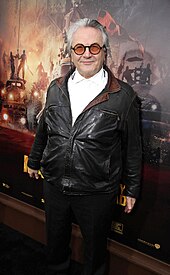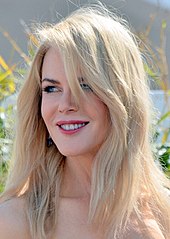| Revision as of 13:46, 6 August 2017 editDimadick (talk | contribs)Autopatrolled, Extended confirmed users, Pending changes reviewers805,649 edits →References← Previous edit | Revision as of 14:14, 11 August 2017 edit undoEmmy Expert (talk | contribs)Extended confirmed users20,500 edits →Notable figuresNext edit → | ||
| Line 103: | Line 103: | ||
| ===Directors=== | ===Directors=== | ||
| ] | ]]] | ||
| ] | ]]] | ||
| {{columns-list|2| | {{columns-list|2| | ||
| *] | * ] | ||
| *] | * ] | ||
| *] | * ] | ||
| *] | * ] | ||
| *] | * ] | ||
| *] | * ] | ||
| *] | * ] | ||
| *] | * ] | ||
| *] | * ] | ||
| *] | * ] | ||
| *] | * ] | ||
| }} | }} | ||
| ===Actors=== | ===Actors=== | ||
| ] | ]]] | ||
| ]{{columns-list|2|*] | ]]] | ||
| {{columns-list|2| | |||
| * ] | |||
| *] | * ] | ||
| *] | * ] | ||
| *] | * ] | ||
| *] | * ] | ||
| *] | * ] | ||
| *] | * ] | ||
| *] | * ] | ||
| *] | * ] | ||
| *] | * ] | ||
| *] | * ] | ||
| *] | * ] | ||
| *] | * ] | ||
| *] | * ] | ||
| *] | * ] | ||
| *] | * ] | ||
| *] | * ] | ||
| *] | * ] | ||
| *] | * ] | ||
| *] | * ] | ||
| *] | * ] | ||
| *] | * ] | ||
| *] | * ] | ||
| *] | * ] | ||
| *] | * ] | ||
| *] | * ] | ||
| *] | * ] | ||
| *] | * ] | ||
| *] | * ] | ||
| *] | * ] | ||
| *] | * ] | ||
| *] | * ] | ||
| *] | * ] | ||
| *] | * ] | ||
| *] | * ] | ||
| *] | * ] | ||
| }} | }} | ||
| ===Others=== | ===Others=== | ||
| *] (cinematographer) | * ] (cinematographer) | ||
| *] (cinematographer) | * ] (cinematographer) | ||
| *] (cinematographer) | * ] (cinematographer) | ||
| *] (cinematographer) | * ] (cinematographer) | ||
| *] (composer) | * ] (composer) | ||
| ==Aftermath== | ==Aftermath== | ||
Revision as of 14:14, 11 August 2017
The Australian New Wave (also known as the Australian Film Revival, Australian Film Renaissance, or New Australian Cinema) was an era of resurgence in worldwide popularity of Australian cinema, particularly in the United States. It began in the early 1970s and lasted until the mid-late 1980s.
The era marked the emergence of Ozploitation, a film genre characterised by the exploitation of colloquial Australian culture.
Background
The Australian film industry declined after World War II, coming to a virtual stop by the early 1960s. The Gorton (1968–71) and Whitlam Governments (1972–75) intervened and rescued the industry from its expected oblivion. The federal and several state governments established bodies to assist with the funding of film production and the training of film makers through the Australian Film Television and Radio School, which fostered a new generation of Australian filmmakers who were able to bring their visions to the screen. The 1970s saw a huge renaissance of the Australian film industry. Australia produced nearly 400 films between 1970 and 1985, more than had been made in the history of the Australian film industry.
In contrast to pre-New Wave films, New Wave films are often viewed as fresh and creative, possessing "a vitality, a love of open spaces and a propensity for sudden violence and languorous sexuality". The "straight-ahead narrative style" of many Australian New Wave films reminded American audiences of "the Hollywood-maverick period of the late 1960s and early '70s that had just about run its course".
Legacy
Several films of the Australian New Wave are regarded as classics of world cinema and have been ranked among films considered the best. Published in 2004, The New York Times Guide to the Best 1,000 Movies Ever Made includes Walkabout, Mad Max, Breaker Morant, Gallipoli, The Road Warrior, The Year of Living Dangerously and Dead Calm. In 2008, Empire magazine chose The Road Warrior and The Year of Living Dangerously as two of the 500 Greatest Movies of All Time, ranking in at #280 and #161 respectively. The 2011 book 1001 Movies You Must See Before You Die features Walkabout, Picnic at Hanging Rock, The Last Wave, The Chant of Jimmie Blacksmith, My Brilliant Career, Mad Max and Gallipoli.
Since its re-release in 2009, Wake in Fright has been assessed as one of, if not the greatest, Australian New Wave film.
Notable films
Notable figures
Many Australian filmmakers and actors launched international careers through their work in the Australian New Wave.
Directors


Actors


Others
- Russell Boyd (cinematographer)
- John Seale (cinematographer)
- Dean Semler (cinematographer)
- Donald McAlpine (cinematographer)
- Brian May (composer)
Aftermath
The term "glitter cycle" refers to a subgenre of eccentric Australian comedies that came to prominence in the early 1990s, spurning a post-new wave revival of Australian film. These films are noted for their celebration of Australian popular culture, camp aesthetic, colourful makeup and costuming, and musical performance pieces. Prominent glitter films include Strictly Ballroom (1992), Muriel's Wedding (1994), The Adventures of Priscilla, Queen of the Desert (1994) and Love Serenade (1996).
Other prominent post-new wave revival films include Babe, The Castle, Proof, Romper Stomper, Shine, The Big Steal, Rabbit-Proof Fence, and Kiss or Kill.
See also
|
|
References
- "Film in Australia". Retrieved 28 June 2009.
- "Film in Australia". Retrieved 28 June 2009./
- Wendy Lewis, Simon Balderstone and John Bowan (2006). Events That Shaped Australia. New Holland. pp. 229–233. ISBN 978-1-74110-492-9.
- Hale, Mike (23 January 2013). "When Australia Soared on Film", The New York Times. Retrieved 24 January 2013.
- "The Best 1,000 Movies Ever Made", The New York Times. Retrieved 26 January 2013.
- "Empire's 500 Greatest Movies of All Time", Empire. Retrieved 26 January 2013.
- Schneider, Steven Jay. 1001 Movies You Must See Before You Die. London: Quintessence Editions Ltd.. ISBN 1844036979
- Buckmaster, Luke (14 February 2014). "Wake in Fright: rewatching classic Australian films", The Guardian. Retrieved 16 May 2015.
- Cave, Nick. "Wake in Fright (brand-new 35mm print!)", The Cinefamily. Retrieved 7 May 2013.
- Gibson, Anthony (18 January 2013). "Lawless director John Hillcoat: Wake In Fright is hands down the greatest Australian movie", Metro. Retrieved 16 May 2015.
- Film Reference Encyclopedia - "Australian New Wave: The Comedies"
- New York Times - "Australia Prides Its 'New Wave' of Films" article, 15 February 1981
| New Wave in cinema | |
|---|---|
| By country | |